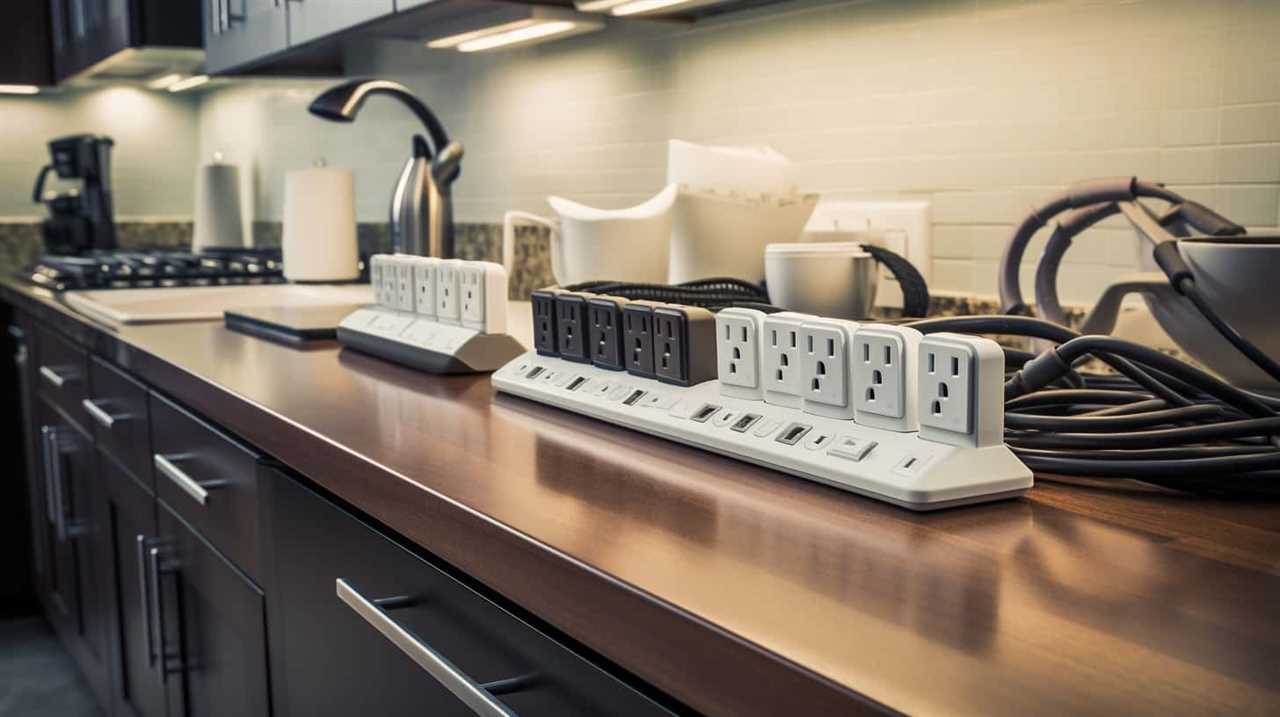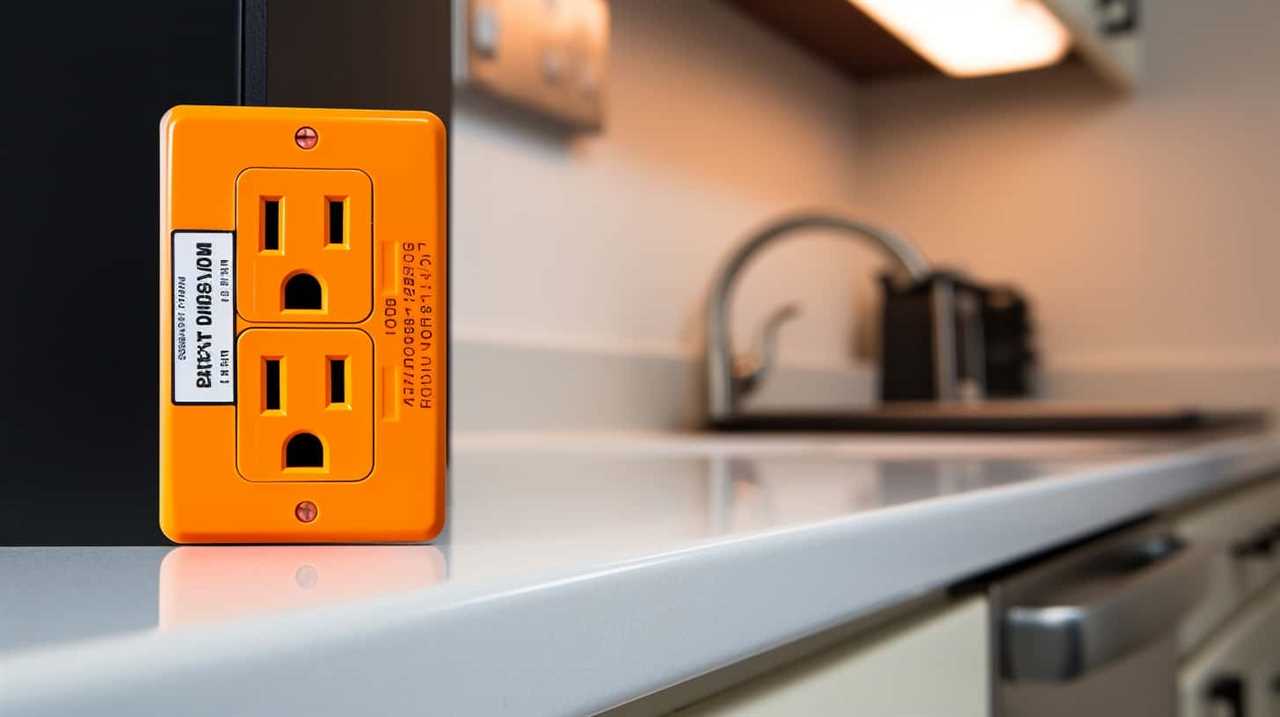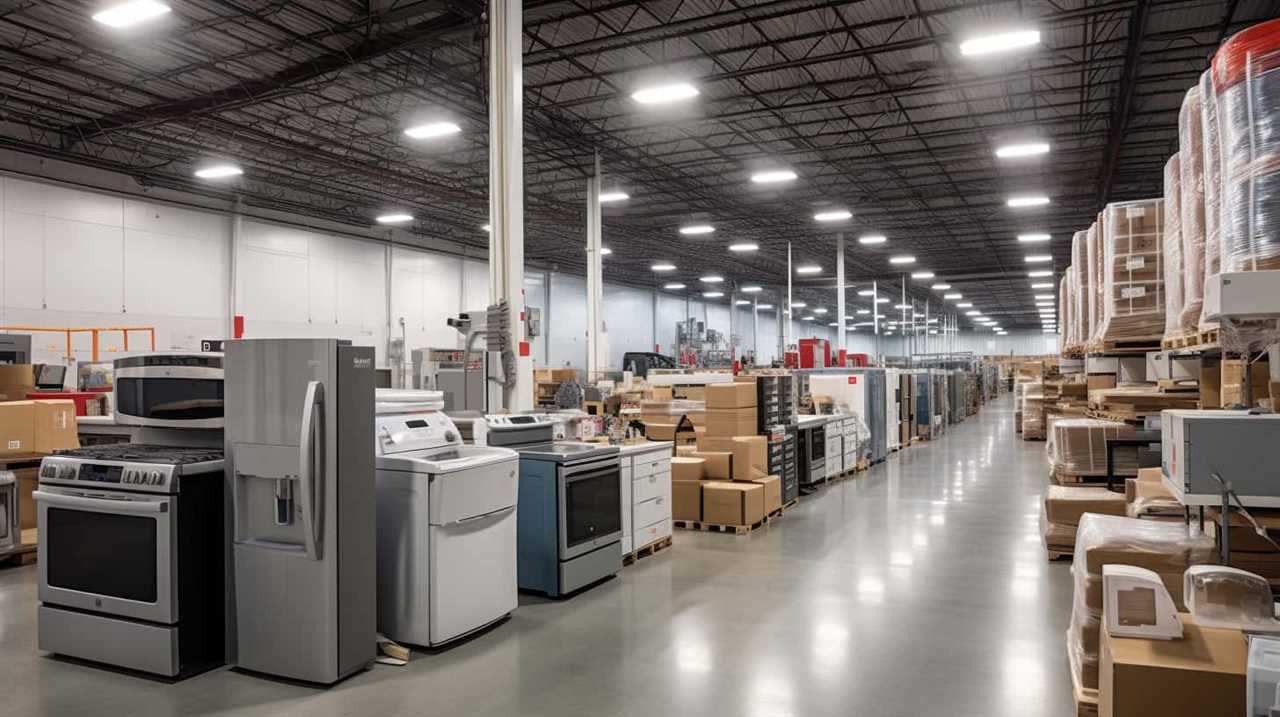Lightning has been a captivating natural occurrence for centuries, with its powerful and unpredictable nature sparking various questions and myths, including those related to electrical appliances.
Many people believe that these devices attract lightning strikes during thunderstorms, causing potential harm to both the appliances and those nearby. However, it is crucial to approach this topic with a scientific and informed perspective.
In this article, we will explore the nature of lightning and debunk the myth surrounding electrical appliances. By understanding the factors that influence lightning strikes and the role of electrical conductivity, we can dispel common misconceptions and ensure our safety during thunderstorms.
Let us delve into the realm of lightning and appliances, separating fact from fiction.

Key Takeaways
- Electrical appliances do not attract lightning simply because they are electrical devices.
- Factors such as the height and location of an object, its conductivity, and the presence of a lightning rod system determine the likelihood of a lightning strike.
- Grounded appliances, when properly installed and maintained, do not attract lightning.
- Following proper safety protocols, such as disconnecting appliances during thunderstorms, minimizes the risk of damage from lightning strikes.
Understanding the Nature of Lightning
To fully comprehend the phenomenon of lightning, one must delve into the intricacies of its nature.
Lightning is a powerful discharge of electricity that occurs during a thunderstorm. It is formed as a result of the separation of positive and negative charges within a cumulonimbus cloud. This separation creates an electric field, which intensifies as the charges accumulate. Eventually, the electric field becomes strong enough to overcome the insulating properties of the air, leading to a rapid discharge of electricity.
Lightning rods, which are installed on tall structures, play a crucial role in protecting these structures from the destructive power of lightning strikes. By providing a path of least resistance for the electrical current, the lightning rod helps to safely conduct the lightning bolt into the ground.
Understanding the nature of lightning formation and the importance of lightning rod installation is essential in order to prevent damage and ensure safety during thunderstorms.

Now, let us explore the process of how lightning forms.
How Does Lightning Form
Lightning forms through the process of the separation and accumulation of positive and negative charges within a cumulonimbus cloud. This phenomenon occurs as a result of complex interactions between ice particles, supercooled water droplets, and updrafts within the cloud.
As the cloud develops, the rising air currents carry ice particles to higher altitudes, while the heavier supercooled water droplets fall towards the base of the cloud. This movement creates a charge separation, with positive charges accumulating at the top of the cloud and negative charges accumulating at the bottom.
The accumulation of these charges eventually leads to a large electrical potential difference, which is discharged as a lightning bolt. Understanding the formation of lightning is crucial for implementing effective lightning safety precautions, such as seeking shelter indoors or in a vehicle during a thunderstorm to avoid the risk of being struck by lightning.

Debunking the Myth: Do Appliances Attract Lightning
The belief that electrical appliances attract lightning is a common myth that needs to be debunked. Lightning is not attracted to appliances simply because they are electrical devices.
Instead, the likelihood of a lightning strike is determined by factors such as the height and location of the object, its conductivity, and the presence of a lightning rod system.
Understanding the science behind these factors will help dispel the misconception surrounding the attraction of lightning to appliances.
Lightning and Grounded Appliances
Grounded appliances, when properly installed and maintained, do not attract lightning. This is a common misconception that needs to be debunked. Grounding appliances is an essential aspect of electrical safety. When an appliance is properly grounded, it is connected to a grounding system that provides a path for electrical current to flow in the event of a fault. This helps protect against electrical shocks and prevents the buildup of excess electrical charge.

However, it is important to note that grounding an appliance does not make it immune to lightning strikes. Lightning is a powerful natural phenomenon that can strike any structure, regardless of whether or not it is grounded. Therefore, it is crucial to follow proper safety protocols, such as disconnecting appliances during thunderstorms, to minimize the risk of damage from lightning strikes.
Conductivity of Electrical Devices
Appliances themselves do not possess the ability to attract lightning strikes, debunking the myth that they do. The conductivity of electrical devices, however, does play a role in determining their susceptibility to lightning strikes. Understanding the concept of electrical resistance is crucial in this context. Appliances with higher resistance are less likely to attract lightning, as they present a greater impedance to the flow of electrical current.
Lightning safety precautions should still be followed, regardless of the conductivity of electrical devices. These precautions include avoiding using appliances during thunderstorms, unplugging them from power sources, and using surge protectors. By taking these measures, the risk of appliances attracting lightning strikes can be minimized.
Transitioning into the subsequent section about lightning rod effectiveness, it is important to note that while appliances do not attract lightning, lightning rods are designed to protect structures from lightning strikes.

Lightning Rod Effectiveness
Lightning rod effectiveness in preventing lightning strikes on electrical appliances has been a subject of debate and misconception. Many people believe that installing a lightning rod on their property will protect their appliances from being struck by lightning. However, the truth is that lightning rods are designed to protect buildings and structures, not individual appliances. While a properly installed and maintained lightning rod can help divert the electrical charge from a lightning strike away from a building, it does not offer direct protection to appliances within the building. To further illustrate this point, consider the following table:
| Lightning Rod Placement | Lightning Rod Maintenance | Lightning Strike Prevention on Appliances |
|---|---|---|
| Correctly positioned at the highest point of a structure | Regular inspection and repair of any damaged components | No direct prevention of lightning strikes on appliances |
| Strategically placed away from trees or other tall objects | Proper grounding of the lightning rod system | No direct prevention of lightning strikes on appliances |
| Adequate number of lightning rods based on the size of the structure | Periodic lightning rod system testing | No direct prevention of lightning strikes on appliances |
Factors That Influence Lightning Strikes
There are several factors that influence the occurrence of lightning strikes. Understanding these factors is crucial in assessing the risk of lightning strikes and implementing safety measures. Here are three key factors that influence lightning strikes:
- Geographical location: Some regions experience a higher frequency of lightning strikes than others. For example, areas with a higher elevation and proximity to large bodies of water are more prone to lightning activity.
- Climate conditions: Thunderstorms, which are the primary source of lightning, occur more frequently in certain climates. Regions with hot and humid conditions, such as tropical and subtropical areas, are more likely to experience thunderstorms and subsequent lightning strikes.
- Topography: The shape and features of the land can affect the likelihood of lightning strikes. Tall structures, such as mountains and tall buildings, can act as lightning attractors, increasing the chances of a strike.
The Role of Electrical Conductivity in Lightning Strikes
The electrical conductivity of objects plays a crucial role in determining their susceptibility to lightning strikes. Lightning is formed when there is a difference in electrical charge between the ground and the atmosphere. Conductive materials allow the flow of electrical current, making them more likely to attract lightning strikes. In contrast, non-conductive materials do not provide a path for the electrical discharge and are less likely to be struck by lightning.
To better understand the impact of electrical appliances on lightning strikes, let’s consider the following table:

| Electrical Appliance | Conductivity | Susceptibility to Lightning Strikes |
|---|---|---|
| Metal roof | High | High |
| Wooden house | Low | Low |
| TV | Moderate | Moderate |
| Cellphone | Moderate | Moderate |
| Power lines | High | High |
From the table, it is evident that objects with higher conductivity, such as metal roofs and power lines, are more likely to attract lightning strikes. On the other hand, objects with lower conductivity, like wooden houses, have a lower susceptibility to lightning strikes. Electrical appliances such as TVs and cellphones, with moderate conductivity, fall in between. It is important to consider the conductivity of objects when assessing their risk of being struck by lightning.
Lightning Protection Measures for Appliances
When it comes to protecting appliances from lightning strikes, there are several key measures that can be taken.
One important measure is the use of surge protectors specifically designed for appliances, which help to absorb and redirect excess electrical energy caused by lightning.
Additionally, grounding electrical appliances is crucial, as it provides a safe path for lightning current to flow into the ground, reducing the risk of damage to the appliances.

Lastly, the installation of lightning rods on buildings can help to attract and safely disperse lightning strikes away from appliances, further enhancing their protection.
Surge Protectors for Appliances
Surge protectors offer effective lightning protection for electrical appliances. These devices are designed to divert excess voltage from power surges, such as those caused by lightning strikes, away from the appliances, thus preventing damage to them. Surge protectors bring several advantages to the table in terms of protecting appliances from lightning:
- Voltage regulation: Surge protectors actively monitor and regulate the voltage supplied to appliances, ensuring a steady and safe flow of electricity.
- Absorption of power surges: Surge protectors are equipped with built-in components that absorb excess voltage and redirect it away from the appliances, shielding them from potential damage.
- Enhanced lifespan: By preventing sudden voltage spikes, surge protectors can significantly extend the lifespan of appliances, reducing the need for frequent replacements.
To maintain the effectiveness of surge protectors, regular maintenance is crucial. This includes inspecting the device for any signs of wear or damage, replacing worn-out surge protectors, and ensuring proper grounding to maximize their performance.
Grounding Electrical Appliances
To ensure effective lightning protection for electrical appliances, it is essential to address the subtopic of grounding electrical appliances and implementing lightning protection measures.

Grounding safety is a crucial aspect of electrical appliance maintenance, as it helps redirect electrical surges caused by lightning strikes and prevents damage to both the appliance and the building’s electrical system. Adequate grounding ensures that excessive electrical current is safely dissipated into the ground, protecting the appliance and minimizing the risk of electrical shock.
This is achieved by connecting the appliance to a grounded electrical outlet or using a grounding wire or rod. Regular inspection and maintenance of the grounding system are also essential to ensure its effectiveness.
Lightning Rod Installation
The installation of a lightning rod is a vital measure for protecting appliances from lightning strikes. A properly installed lightning rod can divert the electrical discharge of a lightning strike safely into the ground, preventing it from damaging appliances or causing electrical surges.
Here are some key points to consider regarding lightning rod installation:

- Lightning rod positioning: Lightning rods should be installed at the highest point of a structure to attract lightning strikes and provide a direct path for the electrical discharge. They should be placed at least 10 feet above any other objects on the structure, such as chimneys or antennas.
- Lightning rod maintenance: Regular inspection and maintenance of lightning rods are crucial to ensure their effectiveness. This includes checking for any damage or corrosion, ensuring proper grounding connections, and clearing any obstructions that may hinder their function.
Lightning Safety Tips for Electrical Appliance Users
When using electrical appliances during a thunderstorm, it is important to follow lightning safety tips to minimize the risk of damage or injury.
One of the most crucial lightning safety precautions is ensuring proper electrical grounding. Grounding provides a path for lightning to safely discharge into the ground, preventing it from causing harm to the electrical system or appliances. To achieve effective grounding, electrical appliances should be connected to a grounding system that meets the necessary specifications and is properly installed.
Additionally, it is important to stay away from using electrical appliances that are not necessary during a thunderstorm, as they can increase the risk of lightning strikes and subsequent damage.
By following lightning safety precautions and implementing proper electrical grounding, the risk of damage or injury can be significantly reduced.

Transitioning to the subsequent section, another important measure in protecting electrical appliances during thunderstorms is the use of surge protectors.
The Importance of Surge Protectors During Thunderstorms
Surge protectors play a crucial role in safeguarding electronic devices during thunderstorms. These devices are necessary as they provide a defense against power surges caused by lightning strikes.
Surge Protector Necessity
During thunderstorms, it is crucial to use surge protectors for electrical appliances to ensure their safety and prevent damage. Surge protectors offer several benefits that make them a necessity during such weather conditions.
The importance of surge protectors during thunderstorms can be summarized as follows:

- Protection against voltage spikes: Surge protectors are designed to divert excess voltage away from your appliances, preventing them from getting damaged due to power surges caused by lightning strikes.
- Safeguarding sensitive electronics: Electrical devices such as computers, televisions, and smartphones are sensitive to voltage fluctuations. Surge protectors filter out these fluctuations, ensuring the longevity and proper functioning of your devices.
- Peace of mind: By using surge protectors, you can have peace of mind knowing that your valuable appliances are protected against unpredictable power surges, reducing the risk of fire hazards and electrical failures.
Protecting Electronic Devices
To ensure the safety of electronic devices during thunderstorms, it is essential to prioritize the use of surge protectors.
Surge protectors play a crucial role in safeguarding electronic devices from power fluctuations and surges caused by lightning strikes. Lightning poses a significant risk to electronic devices due to its high conductivity and the potential for power surges to travel through electrical circuits.
By using surge protectors, these power surges can be diverted away from sensitive devices, preventing damage and potential data loss. It is important to note that surge protectors are not foolproof and cannot provide 100% protection. However, they significantly reduce the risk of damage and are a key component of lightning safety precautions.
To ensure the maximum protection of electronic devices, it is recommended to use high-quality surge protectors and follow additional lightning safety measures.

Lightning Damage Prevention
As thunderstorms can pose a significant risk to electronic devices, it is crucial to prioritize the use of surge protectors to prevent lightning damage. Surge protectors are essential in safeguarding your appliances during thunderstorms. Here are a few reasons why surge protectors are vital for lightning strike prevention and lightning safety precautions:
- Surge protectors act as a barrier, diverting excess electrical energy from lightning strikes away from your devices.
- Surge protectors are designed to absorb and dissipate high voltage surges, safeguarding your appliances from electrical damage.
- Surge protectors provide multiple outlets, allowing you to connect various devices and ensuring they are all protected during a thunderstorm.
By using surge protectors, you can significantly reduce the risk of lightning damage to your valuable electronic devices.
Now, let’s explore common misconceptions about lightning and appliances.
Common Misconceptions About Lightning and Appliances
What are some common misconceptions about lightning and appliances? When it comes to lightning and appliances, there are several misconceptions that people often have. One common misconception is that electrical appliances attract lightning. However, this is not true. Lightning is attracted to tall objects, such as trees, buildings, and lightning rods, rather than individual appliances. Another misconception is that using appliances during a thunderstorm increases the risk of being struck by lightning. While it is generally advisable to unplug appliances during a storm to protect against power surges, using them does not increase the likelihood of being struck by lightning. It is important to understand these misconceptions in order to have a better understanding of lightning safety.

| Misconception | Fact |
|---|---|
| Electrical appliances attract lightning | Lightning is attracted to tall objects, not individual appliances |
| Using appliances during a thunderstorm increases the risk of being struck by lightning | Using appliances does not increase the likelihood of being struck by lightning |
Lightning Strike Statistics and Data
Lightning strike statistics and data provide valuable insights into the frequency and distribution of lightning strikes. Understanding the patterns of lightning strikes can help in developing effective lightning strike prevention measures. Here are some key points to consider:
- Lightning strikes occur approximately 8 million times per day worldwide, with about 100 lightning strikes hitting the Earth’s surface every second.
- Certain regions, such as the equatorial belt and mountainous areas, have a higher incidence of lightning strikes.
- Lightning strikes are more common during the summer months and in the afternoon or early evening.
Conclusion: Debunking the Myth and Staying Safe
After analyzing lightning strike statistics and data, it becomes clear that debunking the myth of electrical appliances attracting lightning is essential for ensuring safety. Understanding lightning misconceptions is crucial in order to provide accurate information to the public. Contrary to popular belief, electrical appliances do not attract lightning. Lightning strikes are primarily determined by the height and shape of objects, as well as the presence of conductive materials. To further debunk this myth, it is important to provide lightning safety guidelines for homes. These guidelines include installing lightning rods, using surge protectors, and avoiding the use of electrical appliances during thunderstorms. By adhering to these safety measures, individuals can significantly reduce the risk of lightning-related accidents and protect their homes from potential damage.
| Lightning Safety Guidelines for Homes |
|---|
| Install lightning rods on high structures |
| Use surge protectors for electrical devices |
| Avoid using electrical appliances during thunderstorms |
| Stay indoors during lightning storms |
| Seek shelter in a fully enclosed building or vehicle |
Frequently Asked Questions
Can Lightning Strike an Appliance if It Is Not Plugged In?
During a thunderstorm, it is possible for lightning to strike an unplugged appliance. To ensure safety, it is advised to unplug all appliances during a storm and avoid using them until the storm has passed.
Will Using an Extension Cord Increase the Chances of My Appliances Attracting Lightning?
Using an extension cord does not increase the chances of appliances attracting lightning. However, to ensure lightning safety for outdoor electrical appliances, it is recommended to use surge protectors as they play a crucial role in preventing lightning damage.

Are There Certain Types of Appliances That Are More Likely to Attract Lightning Than Others?
Certain types of electrical appliances, such as those with metal components or those that are located near windows or outside, may have a higher likelihood of attracting lightning strikes. It is important to take precautions to protect these appliances during thunderstorms.
Is It Safe to Use Electrical Appliances During a Thunderstorm if They Are Not Plugged In?
During a thunderstorm, it is advisable to exercise caution when using electrical appliances, even if they are not plugged in. While the likelihood of attracting lightning is minimal, it is still recommended to unplug appliances and avoid using them during a storm to mitigate any potential risks.
What Should I Do if My Electrical Appliance Is Struck by Lightning?
When an electrical appliance is struck by lightning, common damages can include power surges, circuitry damage, and complete malfunction. To protect appliances, it is advisable to unplug them during storms or utilize surge protectors.
Conclusion
In conclusion, the belief that electrical appliances attract lightning is a common misconception. Lightning strikes are influenced by various factors such as height, shape, and conductivity of objects.

While it is true that electrical systems can be susceptible to power surges during thunderstorms, the use of surge protectors can greatly reduce the risk of damage.
Understanding the nature of lightning and implementing proper safety measures is crucial for staying safe during thunderstorms.










